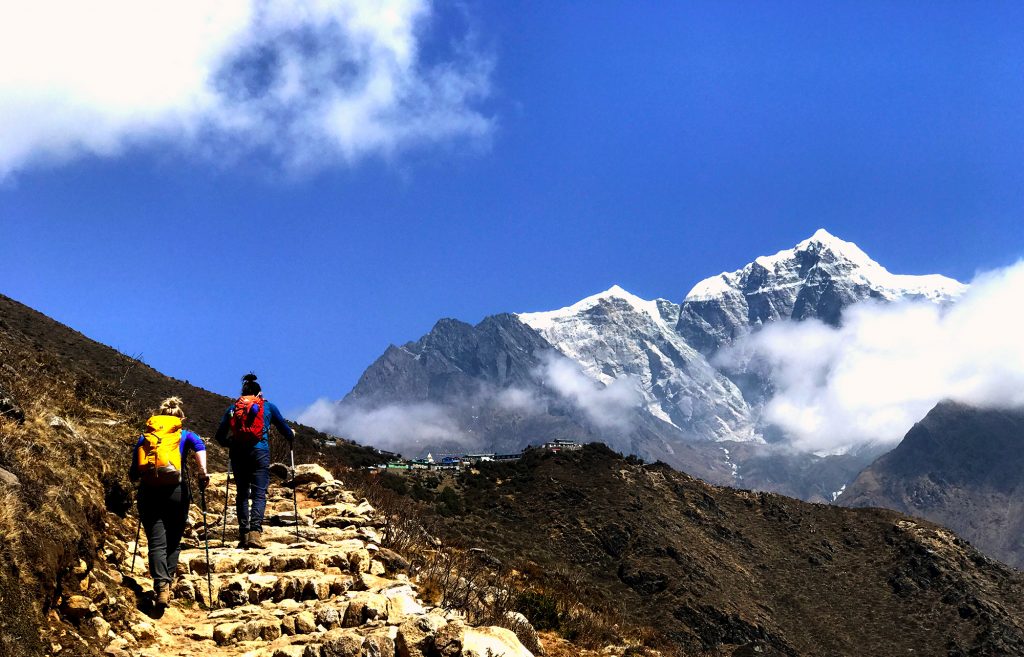
Trekking in the Everest region of Nepal, once a rugged and affordable adventure for backpackers, is now becoming an exclusive luxury expedition.
What was once a low-budget journey to the Himalayas, the world’s most loved backpackers’ destination is now transforming into an exclusive trip, with upgraded transportation via helicopters, luxurious foods, and 4-star accommodation, attracting mostly wealthy travellers.
This shift is changing not only the trekking experience but also the local economy and culture of the region. Hence it is time to ask— is luxury trekking a sustainable path for tourism?
From budget backpackers trekking to luxury trekking
For decades, Everest trekking was a popular choice for budget-conscious adventurers, both foreign and Nepali. Lodging in teahouses was affordable, with daily costs ranging from $20 to $50 for rooms and meals.
However, luxury trekking packages have now pushed prices to new heights. Foreigners spend up to $5000 or more for helicopter rides, private suites, and gourmet dining, while Nepali citizens, who now have to pay Rs 50,000 to 70,000 ($400 to $500), find it nearly impossible to afford the trek.
Santosh Baniya, a senior guide at Discover Altitude Treks has closely observed the shift in the tourism economy of Nepal for over 15 years. He says, “The comfort and services for trekkers have greatly changed in the last five years. Before, we used to see a lot of backpackers choosing Everest, now only the high-end spending tourists choose Everest”.
Economic impact of luxury trekking
Luxury trekking in Everest has undoubtedly boosted the local economy. With high-end trekkers spending more money on premium services, villages like Lukla and Namche Bazaar are seeing increased prosperity. The Everest region, already a major contributor to Nepal’s tourism revenue, now generates millions annually from luxury trekkers alone.
“This new wave of tourists has brought us better jobs and opportunities,” says Dawa Sherpa, another Sherpa guide from Namche. “But it has also driven up the cost of living for everyone.” He adds, “Guiding had been in my family for generations, but with luxury trekking, it’s becoming more about catering to needs of those who can afford it than those who truly want to experience the trek.”
Indeed, while the economic benefits from luxury tourists cannot be overlooked, the cost of goods and services has risen across the board. Necessities, which used to be affordable for locals and budget travellers, have become more expensive due to demand from wealthier tourists. The very success of luxury trekking is pricing out the Nepali population and traditional backpackers.
Pros and cons of luxury trekking
As luxury trekking grows, it brings both advantages and challenges.
Pros:
Economic Benefits: High-end trekkers spend more, creating jobs for guides, porters, and lodge staff. On average, a common tourist spends at least Rs 7,000 per night in the Everest Region, and over Rs 25,000 per night for luxurious facilities. This boosts local economies and contributes to the region’s infrastructure development.
Safety and Comfort: Luxury services include helicopter evacuations, private guides, and high-quality lodges, making the trek safer and more comfortable for those who can afford it.
Attracting High-Spending Tourists: The influx of high-end travellers brings more revenue to the region and supports the development of schools, clinics, and other essential services.
Cons:
Exclusivity: As prices rise, trekking becomes inaccessible to many, including local Nepalis and budget-conscious foreigners. The once-inclusive experience is now becoming a luxury reserved for the wealthy.
Environmental Impact: Helicopters, waste generation, and the development of luxury lodges threaten the fragile environment. With more tourists comes more pressure on the region’s ecosystem. It’s unbelievable that there are AC rooms/ total heated rooms in such a difficult landscape.
Cultural Shift: The sense of community that once focused on saving their local culture, diminishes as luxury tourists prefer foreign-produced goods and foods.
No Roads, High Costs: One key factor driving the high cost of trekking in the Everest region is the absence of motorable roads. While this preserves the authenticity of the trek, it also means that everything-from food to construction materials- must be flown in by helicopter or carried by porters. This makes goods more expensive, further raising costs for both trekkers and locals.
“We have no roads,” says another local from Tengboche village. “Everything has to come by air or on the backs of porters. That’s why prices are so high.”
Balancing luxury with accessibility
Nepal faces a challenge: how to balance luxury tourism with maintaining accessibility for budget travellers and locals. While luxury trekking has brought much-needed economic growth, it risks alienating those who made the Everest trek famous, for those trekkers seeking an affordable adventure.
Offering mid-range options could help strike that balance, providing comfort without excluding those who cannot afford high-end packages. Discounted trekking permits for Nepali citizens could ensure that locals can still explore their own country’s iconic routes. Additionally, sustainable tourism practices, such as limiting helicopter traffic and improving waste management, are critical to preserving the region’s environment.
The future of Everest trekking
Luxury trekking is changing the face of Everest tourism, but it does not have to come at the cost of inclusivity. By embracing both luxury and affordability, Nepal can ensure that the Everest region remains a destination for all types of trekkers.
Lhakpa Sherpa, a longtime porter, sums up the sentiment of many locals: “Luxury trekking is good for business, but we should not forget what made this place a special adventure; the simplicity and the people.”
As Nepal’s tourism industry grows and evolves, it is clear that finding a balance between luxury and tradition will be key to ensuring the future of trekking in the Everest region.

















